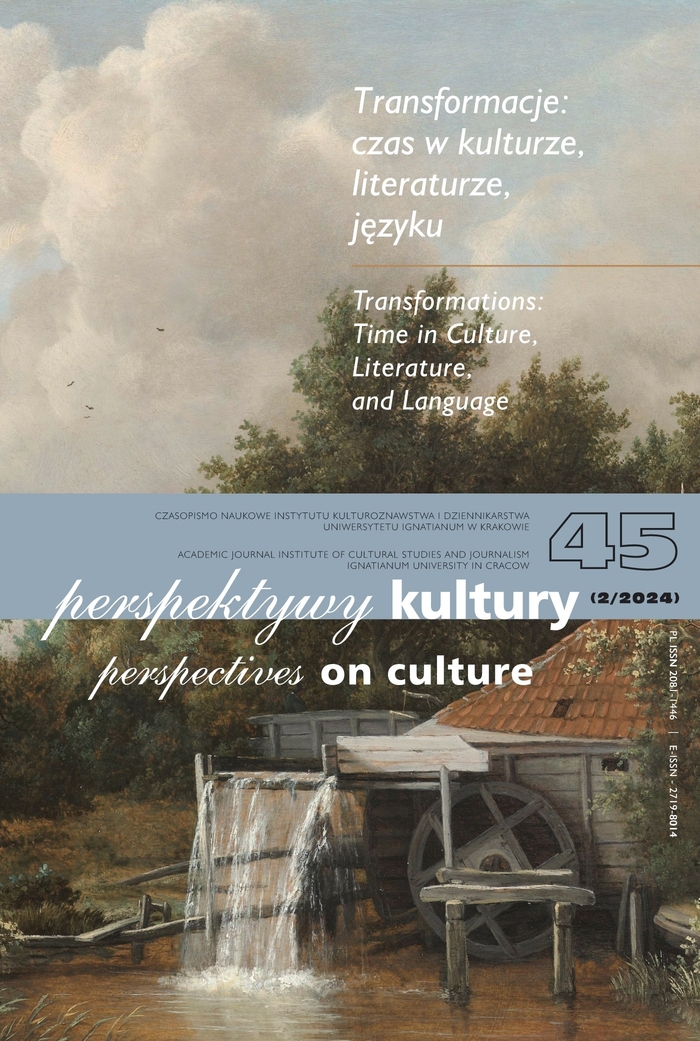Religijność – między mechanizmem obronnym a świadomością
na podstawie Człowiek imieniem Mojżesz a religia monoteistyczna Sigmunda Freuda
Abstrakt
Według Zygmunta Freuda powstanie religii judaistycznej należy łączyć z zabójstwem Mojżesza, którego mieli dokonać względem swojego przywódcy Hebrajczycy. Teza ta, którą psychoanalityk przejął od Ernsta Sellina, stała się podstawą jego rozważań dotyczących traumy stanowiącej źródło doświadczanej przez człowieka nerwicy na tle religijnym. W niniejszym artykule podjęto próbę wykazania, iż podłoże nerwic eklezjogennych nie należy upatrywać w traumatycznych wydarzeniach związanych z czasem wyjścia Izraelitów z Egiptu, jak chciał Freud, ale w indywidualnym podejściu człowieka do religii oraz w przeżywanych przez niego konfliktach wewnętrznych.
Bibliografia
Allport, G.W. (1966). The Religious Context of Prejudice. Journal for the Scientific Study of Religion 5, 447-457.
Assmann, J. (2018). Freud, Sellin, and the Murder of Moses. In: Freud and Monotheism: Moses and the Violent Origins of Religion (ed. G. Sharvit, K.S. Feldman). New York, NY: Fordham University Press, 138-156. DOI: https://doi.org/10.1515/9780823280056-007
Bakan, D. (1958). Sigmund Freud and the Jewish Mystical Tradition. New Jersey, NJ: D. Van Nostrand.
Baron, S. (1939). Moses and Monotheism (Rev.). American Journal of Sociology 45, 476.
Carpenter, E. (2012). Exodus. Evangelical Exegetical Commentary; Bellingham, WA: Lexham Press, I.
Caruth, C. (1996). Unclaimed Experience: Trauma and the Possibility of History (Freud, Moses and Monotheism). In: Unclaimed Experience. Trauma, Narrative, and History. Baltimore, MD: John Hopkins University Press, 10-24.
Chlewiński, Z. (2000). Religia a osobowość człowieka. In: Religia w świecie współczesnym. Zarys problematyki religiologicznej (ed. H. Zimoń). Lublin: TN KUL, 89-126.
Chwalisz, Ł. (2007). Czy psychoanaliza opiera się na myśli kabalistycznej?. Studia Psychologica 7, 267-283.
Cole, R.A. (1973). Exodus: An Introduction and Commentary. Tyndale Old Testament Commentaries; Downers Grove, IL: InterVarsity Press, II.
Cumbee, D.W. (1980). Depression As an Ecclesiogenic Neurosis. The Journal of Pastoral Care 34, 254-267.
Czernianin, W., H. Czernianin, (2017). Zarys teorii psychoanalitycznej Zygmunta Freuda (1856-1939) w perspektywie psychologii literatury, Przegląd biblioterapeutyczny 1, 13-33.
Durham, J.I. (1987). Exodus. Word Biblical Commentary 3; Dallas, TX: Word.
Freud, E.L. (ed.) (1970). The Letters of Sigmund Freud and Arnold Zweig. London: Hogarth.
Freud, S. (1967). Człowiek, religia, kultura. Warszawa: KiW.
Freud, S. (1939). Moses and Monotheism. Letchworth: Hogarth Press.
Freud, S. (1907). Obsessive Actions and Religious Practices. The Standard Edition of the Complete Psychological Works of Sigmund Freud, ed. J. Strachey, London: Hogarth, IX, 115-128.
Freud, S. (2005). Poza zasadą przyjemności, Sixth Edition. Warszawa: PWN.
Freud, S. (1993). Totem i tabu. Warszawa: Wydwanictwo KR.
Griffiths, J.G. (1953). The Egyptian Derivation of the Name Moses. Journal of Near Eastern Studies 12, 225-231.
Hall, C.S., G. Lindzey, J.B. Campbell, (2013). Teorie osobowości. Warszawa: PWN.
Hyatt, J.P. (1940). Freud on Moses and the Genesis of Monotheism. Journal of Bible and Religion 8, 85-88.
Kisiel, A. (2016). Uraz – bliskość – nie-pamięć. Psychoanalityczny dyskurs traumy od Freuda do Ettinger, Narracje o Zagładzie 2, 115-132.
Lemański, J. (2009). Księga Wyjścia. Częstochowa: Edycja św. Pawła.
Malmat, A. (2012). Let My People Go and Go and Go and Go. Egyptian Records Support a Centuries-long Exodus. In: Ancient Israel in Egypt and the Exodus (ed. M. Warker). Washington, DC: Biblical Archaeology Society, 21-30.
Molenda, A. (2015). Wybrane aspekty nerwicy eklezjogennej. Perspektywa psychoterapeuty. In: Religia, religijność, duchowość. W poszukiwaniu nowych perspektyw (ed. H. Grzymała-Moszczyńska – D. Motak). Kraków: Wydawnictwo Uniwersytetu Jagiellońskiego, 189-199.
Molenda, A. (2013). Obraz wymagań Boga w nerwicy eklezjogennej. Przegląd Religioznawczy 247, 177-195.
Morrow, W.S. (1998). Toxic Religion and the Daughters of Job. Studies in Religion 27, 263-276.
Nurmela, R.O. (2016). Moses: Freud’s Ultimate Project. Jewish Studies in the Nordic Countries Today 27, 223–242. DOI: https://doi.org/10.30674/scripta.66577
Okon, E.E. (2012). Akhenaton and Egyptian Origin of Hebrew Monotheism. American Journal of Social Issues & Humanities 6, 418-427.
Pfeifer, S. (1994). Faith-Induced Neurosis: Myth or Reality?. Journal of Psychology and Theology 22, 87–96.
Propp, W.H.C. (2008). Exodus 1—18: A New Translation with Introduction and Commentary. Anchor Yale Bible; New Haven, CT – London: Yale University Press, II.
Prusak, J. (2016). Distinguishing Between the Conscience and the Superego of Religious People in the Context of Treatment of Ecclesiogenic Neurosis. Psychoterapia 179, 33-44.
Schaetzing, E. (1955). Die ekklesiogenen Neurosen. Wege zum Menschen 7, 97–108.
Sellin, E. (1910). Einleitung in das Alte Testament. Leipzig: Quelle & Meyer.
Sellin, E. (1924). Geschichte des israelitisch-juedischen Volkes. Leipzig: Quelle & Meyer.
Sellin, E. (1928). Hosea und das Martyrium des Mose. Zeitschrift für die alttestamentliche Wissenschaft 46, 26-33.
Sellin, E. (1922). Moses und seine Bedeutung für die israelitisch-jüdische Religionsgeschichte. Leipzig: A. Deichertiche.
Stasiewicz, P. (2014). Książę nicości R. Scotta Bakkera i Freudowska krytyka religii. In: Motywy religijne we współczesnej fantastyce (ed. M.M. Leś – P. Stasiewicz). Białystok: Wydawnictwo Uniwersytetu w Białymstoku, 189-201.
Waszkowiak, J.J. (2022). Analogie i korelacje między religią Echnatona a jahwizmem. Biblica et Patristica Thoruniensia 15, 25-49. DOI: https://doi.org/10.12775/BPTh.2022.013
Wnuk, M., J.T. Marcinkowski (2012). Dojrzała religijność – struktura oraz przejawy w życiu człowieka. Problemy Higieny i Epidemiologii 93, 244-247.
Zimnica-Kuzioła, E. (2012). Główne stanowiska w psychologii religii – wprowadzenie. Kultura i wartości 1, 57-71.
Copyright (c) 2024 Perspektywy Kultury

Utwór dostępny jest na licencji Creative Commons Uznanie autorstwa – Bez utworów zależnych 4.0 Międzynarodowe.
Autor, zgłaszając swój artykuł, wyraża zgodę na korzystanie przez Wydawnictwo Uniwersystet Ignatianum z utworu na następujących polach eksploatacji:
- utrwalania utworu w formie papierowej, a także na nośniku cyfrowym lub magnetycznym;
- zwielokrotnienia utworu dowolną techniką, bez ograniczenia ilości wydań i liczby egzemplarzy;
- rozpowszechniania utworu i jego zwielokrotnionych egzemplarzy na jakimkolwiek nośniku, w tym wprowadzenia do obrotu, sprzedaży, użyczenia, najmu;
- wprowadzenia utworu do pamięci komputera;
- rozpowszechniania utworu w sieciach informatycznych, w tym w sieci Internet;
- publicznego wykonania, wystawienia, wyświetlenia, odtworzenia oraz nadawania i reemitowania, a także publicznego udostępniania utworu w taki sposób, aby każdy mógł mieć do niego dostęp w miejscu i czasie przez siebie wybranym.
Wydawca zobowiązuje się szanować osobiste prawa autorskie do utworu.





